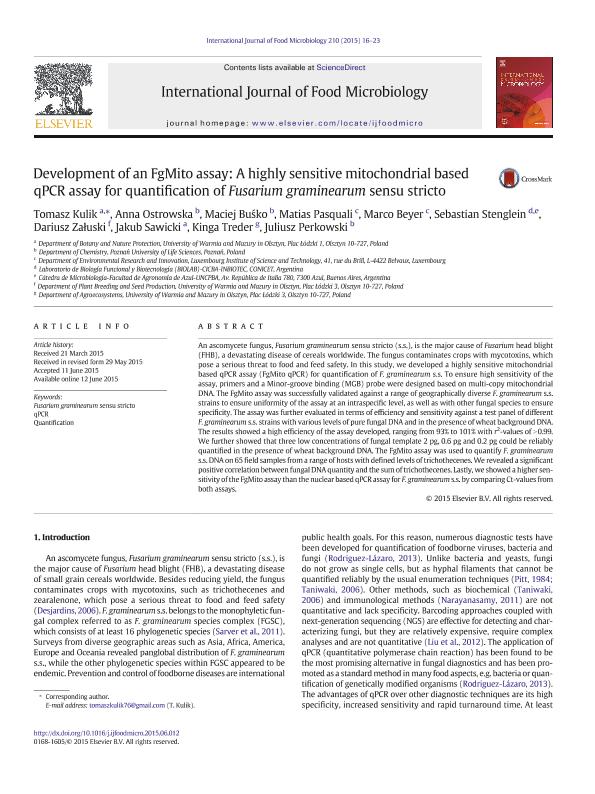Mostrar el registro sencillo del ítem
dc.contributor.author
Kulik, Tomasz
dc.contributor.author
Ostrowska, Anna
dc.contributor.author
Buśko, Maciej
dc.contributor.author
Pasquali, Matias
dc.contributor.author
Beyer, Marco
dc.contributor.author
Stenglein, Sebastian Alberto

dc.contributor.author
Załuski, Dariusz
dc.contributor.author
Sawicki, Jakub
dc.contributor.author
Treder, Kinga
dc.contributor.author
Perkowski, Juliusz
dc.date.available
2017-10-25T14:51:43Z
dc.date.issued
2015-06
dc.identifier.citation
Kulik, Tomasz; Ostrowska, Anna; Buśko, Maciej; Pasquali, Matias; Beyer, Marco; et al.; Development of an FgMito assay: a highly sensitive mitochondrial based qPCR assay for quantification of Fusarium graminearum sensu stricto; Elsevier Science; International Journal of Food Microbiology; 210; 6-2015; 16-23
dc.identifier.issn
0168-1605
dc.identifier.uri
http://hdl.handle.net/11336/27068
dc.description.abstract
An ascomycete fungus, Fusarium graminearum sensu stricto (s.s.), is the major cause of Fusarium head blight (FHB), a devastating disease of cereals worldwide. The fungus contaminates crops with mycotoxins, which pose a serious threat to food and feed safety. In this study, we developed a highly sensitive mitochondrial based qPCR assay (FgMito qPCR) for quantification of F. graminearum s.s. To ensure high sensitivity of the assay, primers and a Minor-groove binding (MGB) probe were designed based on multi-copy mitochondrial DNA. The FgMito assay was successfully validated against a range of geographically diverse F. graminearum s.s. strains to ensure uniformity of the assay at an intraspecific level, as well as with other fungal species to ensure specificity. The assay was further evaluated in terms of efficiency and sensitivity against a test panel of different F. graminearum s.s. strains with various levels of pure fungal DNA and in the presence of wheat background DNA. The results showed a high efficiency of the assay developed, ranging from 93% to 101% with r2-values of > 0.99. We further showed that three low concentrations of fungal template 2 pg, 0.6 pg and 0.2 pg could be reliably quantified in the presence of wheat background DNA. The FgMito assay was used to quantify F. graminearum s.s. DNA on 65 field samples from a range of hosts with defined levels of trichothecenes. We revealed a significant positive correlation between fungal DNA quantity and the sum of trichothecenes. Lastly, we showed a higher sensitivity of the FgMito assay than the nuclear based qPCR assay for F. graminearum s.s. by comparing Ct-values from both assays.
dc.format
application/pdf
dc.language.iso
eng
dc.publisher
Elsevier Science

dc.rights
info:eu-repo/semantics/openAccess
dc.rights.uri
https://creativecommons.org/licenses/by-nc-sa/2.5/ar/
dc.subject
Qpcr
dc.subject
Fusarium Graminearum Sensu Stricto
dc.subject
Quantification
dc.subject.classification
Otras Agricultura, Silvicultura y Pesca

dc.subject.classification
Agricultura, Silvicultura y Pesca

dc.subject.classification
CIENCIAS AGRÍCOLAS

dc.subject.classification
Bioquímica y Biología Molecular

dc.subject.classification
Ciencias Biológicas

dc.subject.classification
CIENCIAS NATURALES Y EXACTAS

dc.subject.classification
Ética relacionada con Biotecnología Agrícola

dc.subject.classification
Biotecnología Agropecuaria

dc.subject.classification
CIENCIAS AGRÍCOLAS

dc.title
Development of an FgMito assay: a highly sensitive mitochondrial based qPCR assay for quantification of Fusarium graminearum sensu stricto
dc.type
info:eu-repo/semantics/article
dc.type
info:ar-repo/semantics/artículo
dc.type
info:eu-repo/semantics/publishedVersion
dc.date.updated
2017-10-11T17:42:19Z
dc.journal.number
210
dc.journal.pagination
16-23
dc.journal.pais
Países Bajos

dc.journal.ciudad
Ámsterdam
dc.description.fil
Fil: Kulik, Tomasz. University of Warmia and Mazury; Polonia
dc.description.fil
Fil: Ostrowska, Anna. Poznań University of Life Sciences. Department of Chemistry; Polonia
dc.description.fil
Fil: Buśko, Maciej. Poznań University of Life Sciences. Department of Chemistry; Polonia
dc.description.fil
Fil: Pasquali, Matias. Luxembourg Institute of Science and Technology; Luxemburgo
dc.description.fil
Fil: Beyer, Marco. Luxembourg Institute of Science and Technology; Luxemburgo
dc.description.fil
Fil: Stenglein, Sebastian Alberto. Consejo Nacional de Investigaciones Científicas y Técnicas. Centro Cientifico Tecnolológico Mar del Plata. Instituto de Investigaciones en Biodiversidad y Biotecnología. Laboratorio de Biologia Funcional y Biotecnología; Argentina. Fundación para Investigaciones Biológicas Aplicadas; Argentina. Universidad Nacional del Centro de la Provincia de Buenos Aires; Argentina
dc.description.fil
Fil: Załuski, Dariusz. University of Warmia and Mazury; Polonia
dc.description.fil
Fil: Sawicki, Jakub. University of Warmia and Mazury; Polonia
dc.description.fil
Fil: Treder, Kinga. University of Warmia and Mazury; Polonia
dc.description.fil
Fil: Perkowski, Juliusz. Poznań University of Life Sciences. Department of Chemistry; Polonia
dc.journal.title
International Journal of Food Microbiology

dc.relation.alternativeid
info:eu-repo/semantics/altIdentifier/doi/http://dx.doi.org/10.1016/j.ijfoodmicro.2015.06.012
dc.relation.alternativeid
info:eu-repo/semantics/altIdentifier/url/http://www.sciencedirect.com/science/article/pii/S0168160515300362
Archivos asociados
